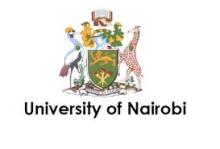Resource information
This thesis examines water quality status and deterioration in the Upper-
Athi-Nairobi sub-catchments which covers an area of 1154.4 km2 with an annual
discharge rate of 99242 m3/year (9.9 X 104 m3/yr). It is based on field and
laboratory analysis of water quality parameters.
The subject matter includes the assessment of land use processes
responsible for water quality deterioration. These include Industrial and
Agricultural activities. The study demonstrates how useful industrial
(manufacturing) and agricultural (irrigation) activities are to the water quality
deterioration for different uses. No detailed work of this kind has been carried
out in Kenya so far and certainly not in the Nairobi river sub-catchments.
Water samples were collected from the two distinctive land use activities
and analysed for the different water quality parameters, notably heavy metals
and pesticides.
Heavy metals especially Mercury and Lead were found to' have high
concentrations above the critical WHOand the Kenya standards
[Mercury =0.03 and Lead =0.1 mg/L]. Other elements with harmful effects to
Human health such as Fluoride and Nitrate were found to have concentrations
surpassing the required WHOand keriya standards. Fluoride was measured at 2.5
rngZL and Nitrate at 0.5 mg/litre (L). Pesticide residues in water notably DDT,
"Ambush" ,"Ridomil", "Malathion" etc were all found to surpass the WHOand Kenya
standards for drinking water. DDT was measured at 0.000086 mg/L "Ambush"
0.1413 mgZL, "Ridomil" 0.147 rngZL, "Malathion"0.00039 mg/L. Their variations in
mass loadings per day are represented in table 48.
,
xi
Generally water quality was found to deteriorate from one river to another
in respect to the landuse activities at its proximity. Their rates of deterioration
were also found to vary. Ngong River exhibited the highest water quality
deterioration with a rate of 0.42 at Embakasi, followed by Nairobi River at
Dandora with a rate of 0.39. Kamiti River and Kasarani had the least rates of
rt<..
deterioration. This were well depicted in figure 13. These corresponded or
conformed well with the land use activities along their water courses.
Water pollutants were also found to vary with time (season) from one river
course to another. CODand BODdemonstrated a time persistence nature for most
rivers and the same with TDS. These again showed close relationship with the
land use processes. Their sources were also demonstrated to relate most to the
land-use activity.
The deterioration in water quality within the study area suggested harmful
effects to the human especially as it relates to
domestic usages of the water. This mostly related to surpasses of some water
quality parameters (e.g. Fluoride, Mercury, Pesticides such as DDT and
"Malathion") of the recommended WHOand the Kenya quideline standards for
drinking water quality.
The study recommends an evaluation of the water quality status for
different uses within the study areas and especially groundwater and surface
waters. Human health aspects should also be considered. There must be j shiftt
towards proper land-water-conservation practices in-corporated within the
management of water resources. This must take in consideration the quality of
the waters and the sources of the water pollutants.


